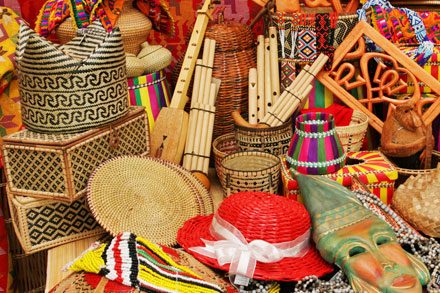Decorate your home or office with exotic tribal artifacts and collectibles from South East Asia’s Borneo Island.

Artifacts of the region consist of wood carvings, metal work, basketry, beadwork, bamboo carvings, blow guns, masks, carved statues, textiles and floor mats. Many of the Borneo handicrafts incorporate beliefs of tribal people and their way of life. The simplest natural materials – wood, rattan and bamboo – are used to make unique and high quality handcrafts.
Handcraft among the indigenous people of Sabah originates in their efforts to shelter, clothe and feed themselves in the best way they can. They produce a wide range of items which are mainly for functional rather than for decorative use.
These include household and domestic items and implements, farming and hunting equipment as well as ritual and ceremonial objects. Their handcrafts are traditionally influenced by both environmental resources and culturally determined needs.
There is wide variation between the crafts produced by peoples of different cultures in the various districts. Coastal peoples relying on sea fishing, for example, have created different implements from those of the interior groups which practise hill or wet rice cultivation and forest hunting with river fishing. Differences also exist between the material cultures of peoples utilising wet rice and those cultivating hill rice.
The differences apply not only to utilitarian implements, but also to ritual objects, musical instruments and other features of material culture.
The availability of local materials also influence the nature of handcrafts. In the Tambunan District, for example, the use of bamboo for making utensil, baskets, houses (including roofing) and fencing is widespread amongst the Tambunan Dusun/Kadazan.
Similarly, the location of bitter gourd produced in Tambunan has helped to establish this place as a centre for the production of sompoton, mouth organs which are traded throughout other Dusunic groups, although these intruments are sometimes made in other places.
Rattan is another durable material widely used by interior peoples with access to forest resources for making hats, baskets, decorative wall hangings and for binding wood or bamboo pieces together.
Material for traditional clothing are also derived from local plants, and include bark, cotton, or fibres derived from pinapple, banana or coconut plants.
Sarawak’s Arts, Crafts and Potted Culture is well-known for its rich diversity of traditional handicrafts.
Ethnic wood-carvings, beadworks, textile-weaving and bamboo and rattan baskets are of intricate indigenous designs and motifs and are distinguished by their fine craftsmanship and often, vibrant colours.
Among these are the ‘pua kumbu’ (handwoven Iban textile), the ‘kain songket’ (handwoven cloth inlaid with gold by the Malays), the ‘terindak’ hats by the Melanaus, the Penan ‘ajat’ baskets and sleeping mats, the Kenyah Sa’ong sunhats, the Iban ‘parang ilang’ (long sword) and a host of other handicrafts.
Sarawak‘s indigenous artefacts and handicrafts are available at many of the souvenir and antique and curio shops to be found in Kuching and in the major urban centres.
Native hats and beads will vary as the different towns have different concentrations of ethnic groups. In Kuching and the rest of Southern Sarawak, expect to find more Bidayuh handicrafts, in Central Sarawak (around Sibu), the handicrafts found will be mainly that of the Iban and the Melanau while in Northern Sarawak, Orang Ulu handicrafts are easily found.
The Arts and Handicraft Centre is situated alongside the Brunei River on Jalan Residency, and it is where the traditional arts and crafts of Brunei Darussalam have been revived.
Here traditional, intricately designed sarongs are woven using gold or silver threads called ‘jong sarat’. They have been worn on ceremonial occasions for centuries, and are valued as heirlooms and collector’s pieces.
Hand-tooled silver jewellery and artifacts, such as ornamental cannon and the snake-like dagger known as the ‘keris’, can be purchased from the centre’s handicrafts shop.
The centre is open daily from 7.45 am to 12.15 pm and from 1.30pm to 4.30 pm, except on Friday and Sunday when it opens between 8.30 am and 2.00 pm.
 Handicrafts? Please Vote!
Handicrafts? Please Vote!


